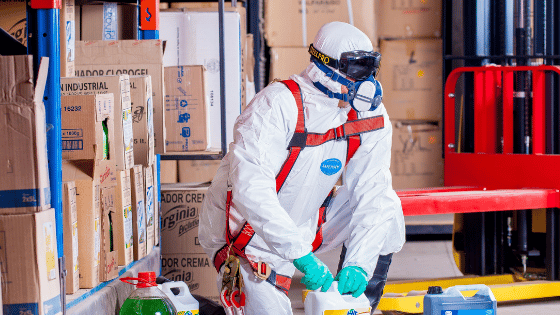
No one wants mould in their living environment or their workspace. It can cause allergic reactions and even greater respiratory symptoms that range from mild to severe. Children, seniors, and those people with some existing medical conditions are the most vulnerable to the effects of mould. While you might feel that getting rid of mould calls for drastic measures, chemicals might pose an even more significant threat.
Products sold for mould removal are classified as fungicides or fungistats, biostats, antimicrobial enzymes, encapsulants, and sealants. ¹ All these products contain harsh chemicals. Using them in your home or environment often has the expected impact on mould. It also has several unintended consequences that make them a less than ideal solution for mould removal.
When you take antibiotics to treat an infection, stopping too soon only causes your condition to get worse. That’s because the lesser dosage of the medicine kills the weaker bacteria and lets the more resistant ones thrive. The same is true when you use chemicals to get rid of mould.
Use of some chemicals covers mould so that it is more difficult to detect. Mould inhibitor paint helps prevent future growth but prevents the evidence from developing that alerts you to its presence. For example, if your bedroom is prone to spots of mould on the walls and ceiling, adding a mould inhibitor to the paint might eliminate the signs of mould growth without getting rid of the mould itself.
Oxidising chemicals like bleach also remove the evidence of mould. Although treatment makes the surface look clean, it leaves the fragments of mould behind that cause contamination. These chemicals make the problem worse and the job of locating and removing the mould harder and more expensive.
Mould thrives in moist environments. Coatings and sealants designed to form a barrier between the mould and moisture sometimes have the opposite effect. Applying these chemicals instead of removing the mould can lead to a buildup of moisture that leads to future mould growth. It can also contribute to structural damage to the area without presenting any evidence on the outside.
Chemicals often have unpredictable results, especially when they’re chemicals we use for everyday household chores. Although a specific type of chemical behaves in one way in one situation, it differs completely in another. That includes household bleach. Most of us think of bleach as a safe way to kill all kinds of germs. But using it to clean mould not only doesn’t work; it can make the problem worse.
When bleach is applied to mould on a porous surface, it increased mould growth by building up more moisture. Chemicals that kill mould can stimulate the production of toxins, making it more dangerous than it was before.
Some chemicals used in mould removal cover, seal or coat the mould growth. Others are designed to kill the mould and create a sterile (germ-free) surface. These products fall short and leave mould spores behind. These chemicals create a false sense of security that the mould is no longer a threat to the environment or any of its inhabitants. The appearance of the surface and the toxicity of the mould are two different issues. However, these products don’t have a complete effect on the presence of mould or the appearance of the surface.
Most mould forms dormant spores when it’s exposed to chemicals. These spores “go to sleep” until the chemicals disappear, and the environment is once again favourable for their growth. No chemical, including those in gas form, can safely and effectively kill mould.
This consequence of chemical treatment for mould is the primary reason that removal is the best option. Even if the chemical kills all the mould, it doesn’t eliminate the threat to humans, animals, or structures. Even when the mould is dead and no longer growing, it is allergenic and has the potential to be toxic.
Although the chemicals used in mould removal don’t efficiently kill mould, they are designed to kill living things. Most chemicals that harm one living thing are dangerous to others as well. That means your use of chemicals at home puts you, your children, and your pets at risk. At work, your employees endure the risk of chemical exposure. In other words, you could harm the very people that you are trying to protect!
Mould and the negative impact it has on people’s health is becoming an increasing problem across Australia. As a result, more home and business owners are turning to chemicals as a means of mould removal. Some people attempt to take care of the problem themselves. They purchase chemicals and apply them, assuming they worked as promised. In many cases, they’re covering the physical signs of mould growth without getting rid of the source of the toxins. Sometimes mould growth resumes without the physical signs that were previously present. The people living or working in the affected environment don’t even realise they’re exposed to mould toxins.
Others hire professional companies to apply the chemicals for them. This isn’t an effective method for removing mould either. The problem isn’t with the quality of the substances or the process of application. It’s with the ineffectiveness of the chemicals that are available for this specific purpose.
The best method is prevention. Identify problem areas where moisture collects and correct them. Ensure your home or business has proper ventilation and repair leaks in the gutters or on your roof.
Once mould growth occurs, physical removal of the mould covered surfaces is the only safe way to get rid of it. Sanding the area yourself is also risky. Hiring a professional to remove the mould as soon as you realise there’s a problem is the safest choice.
1. “Ten Unintended Consequences of Using Antimicrobials for Removal”, Banta, John C., CIH
Call PureProtect now on 1800 664 602.
PureProtect Pty Ltd © 2020. All rights reserved